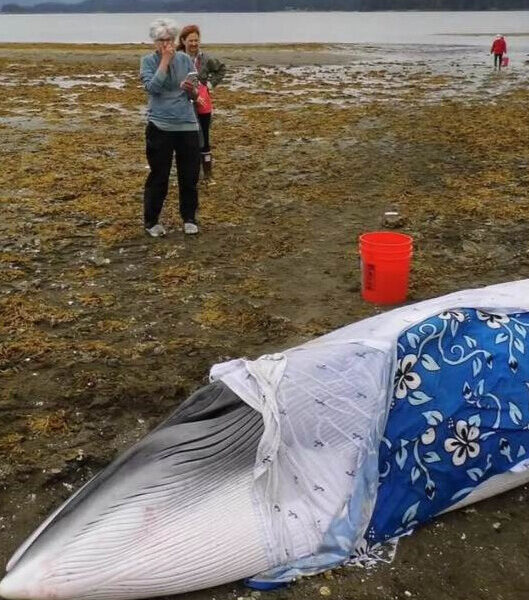The rescue began on an otherwise quiet day when locals spotted something alarming — a large minke whale stranded on the rocky shoreline at low tide. The 15-foot-long animal lay on its side, its massive body wedged awkwardly against the stones, its blowhole dangerously close to the waterline. Experts know that in such situations, time is everything. A beached whale can drown or suffer fatal organ damage in as little as 10 to 20 minutes without the support of the ocean’s buoyancy.
This whale’s plight was especially dire. It was suspected to be suffering from poisoning caused by an algal bloom, a condition that could have left it disoriented and unable to navigate safely. Without help, its fate was almost certain.
But help was already on the way. Word of the stranded whale spread quickly through the community, and soon a small crowd gathered. About 15 locals, many of them complete strangers to each other, dropped everything they were doing to come to the shoreline. There was no debate, no hesitation — just a shared urgency to act.
Understanding that the whale’s skin and internal organs were at risk from the sun and the crushing pressure of its own weight, the group formed a bucket brigade. They hauled seawater from the ocean and poured it over the whale’s exposed underbelly, keeping it cool and moist. Others soaked beach towels and draped them over its back to shield it from the blistering sunlight. The animal’s skin was already scratched and scraped from the rocks, making the protection even more critical.
Rescuers knew they couldn’t attempt to push or drag the animal without risking serious injury to both themselves and the whale. At roughly 3 tons, the minke was far too heavy, and its occasional thrashing made any hands-on movement dangerous. The only viable plan was to keep it alive until the tide returned to lift it free.
Hour after hour, the group worked in unison, their movements becoming a rhythm — fill, pour, drape, repeat. The tide was slow to rise, but no one left. Some stood ankle-deep in icy water, while others knelt on the sharp rocks, carefully avoiding the whale’s fins and flukes. They spoke in low, reassuring voices, as if the animal could understand that it wasn’t alone.
Against the odds, the minutes turned into hours. The dangerous 20-minute survival window stretched to an incredible six hours, thanks to the tireless care of the rescuers. Finally, the ocean began to reclaim the shore. The water crept around the whale’s body, lifting it slightly at first, then more with each passing wave.
In one powerful motion, the minke righted itself. There was a pause — almost as if it were gathering its strength — and then, with a surge of energy, it slid back into deeper water. The crowd erupted in cheers, watching as the whale swam into the open sea.
In the days that followed, it was spotted again offshore, spouting and moving freely. For the community, it was more than a successful rescue; it was a moment that underscored the profound connection between humans and the natural world.
Those who were there will remember it not just as the day they saved a whale, but as proof that when compassion and determination come together, even the most impossible odds can be overcome.





